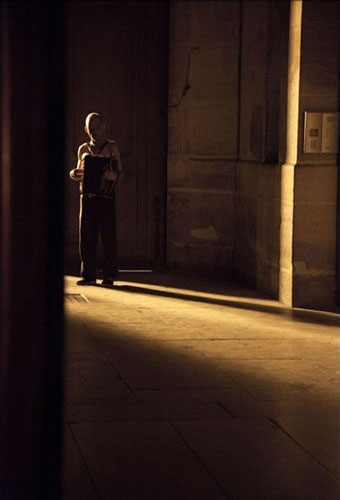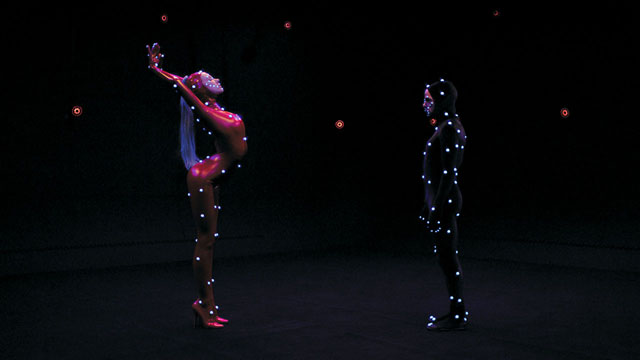“Unclassifiable, expansive, and breathtaking, Holy Motors, the first feature-length film from Leos Carax since Pola X (1999)—and only his fifth in 28 years—received a log line of sorts from its writer-director at the press conference following the movie’s world premiere at Cannes,” begins Melissa Anderson in the Voice. “‘This is a film about a man and the experience of being alive,’ the journo-averse auteur finally said after swatting down one obtuse plea after another to explain ‘what it all meant.’ (I was there.) The statement, initially coming across as an evasion, now rings, especially after a second viewing, as a poetic précis.”
Our first round of reviews came straight from that Cannes premiere, the second from the film’s run in the U.K., coinciding with its engagement at the New York Film Festival. Today, Holy Motors opens in New York at Film Forum and Elinor Bunin Munroe Film Center and, because it’s one of the cinematic events of the year, here we go round again. For those just now tuning in, a briefing, courtesy of Stephanie Zacharek, writing for NPR: Denis Lavant “plays Monsieur Oscar, a man with a very important job to do—although exactly what that job is, we never quite learn. He’s ferried around the city to a series of ‘appointments’ by Celine, an elegant specter of a woman whose white pantsuit matches the stretch limo she drives. (She’s played by Edith Scob, the regal actress who, as a young woman, played the disfigured daughter in Georges Franju’s Eyes Without a Face.)… Oscar transforms himself—using the ever-increasing spaciousness of the limo’s back seat as his dressing room—into a hit man assigned to kill a thug who will become his own double; a dying man attended by his grief-stricken niece; and the former lover (or so it seems) of a mysterious woman in a trench coat and a Jean Seberg wig. That woman is played by [Kylie] Minogue, who sings a plaintive melody that’s like an aural butterfly net, catching wisps of the picture’s shifting moods of melancholy and joy.”
“There’s a particular Parisian tradition that seems peculiar to French aesthetics involving a certain license to behave like a depraved lunatic and receive approval, endorsement, and other cultural rewards in return for this boorishness,” writes Jonathan Rosenbaum. “I suppose one very bourgeois way of describing this tendency would be to call it the aesthetics of self-indulgence combined with a gift for self-promotion… Even though not all artists with these characteristics are French, much less Parisian, it could perhaps be argued that those who are commonly celebrated for these traits are typically appreciated either by French critics (Nicole Brenez writing about Abel Ferrara) or Francophile critics (such as Adrian Martin writing about Philippe Grandrieux, among many others). I share some of their taste for this kind of aggressive provocation and exalted excess while another part of me, at least part of the time, tends to stand outside this predilection and question it a little…. One reason why I tend to prefer Carax to [Philippe] Garrel is a punklike politics that takes some of his bratty attitudes beyond self-absorption, even though autobiography continues to play a very pronounced role, making it necessary at times to decode some of the works via personal references.” Also, “it’s worth recalling that the celebration of grossly uncouth and unmotivated street violence in Merde [Carax’s contribution to the omnibus film Tokyo!], virtually reprised in Holy Motors, is little more than an extended riff on Le Testament de Docteur Cordelier [1959], a lesser-known effort by that often-sentimentalized humanist Jean Renoir, a film which is itself a kind of variation on Renoir’s own, much earlier Boudu sauvé des eaux [1932].”
In the New York Times, where Mekado Murphy has Carax talk us through a scene (3’08”), Manohla Dargis calls Holy Motors “a dream of the movies that looks like a movie of dreams…. And while at times it feels as if Holy Motors had been cobbled together from a million movies, it mostly, wonderfully, feels unlike anything else: it’s cinema reloaded.”
Writing for Artforum, Andrew Hultkrans argues that Holy Motors is “largely a multivalent study of Denis Lavant’s body. It is also a brilliantly metatextual, multigenre meditation on what Jean Baudrillard called ‘the disappearance of the real’ in the face of the encroaching digitization of everything, as well as a fictional realization of Erving Goffman’s 1959 classic of sociology, The Presentation of Self in Everyday Life…. Managing to be visually sumptuous, engagingly kinetic, and thumpingly entertaining while flouting most laws of narrative (lacking even the internal ‘consistency’ of dream logic), it is also something of a throwdown to contemporary (particularly American) filmmakers to get off their script-doctored, focus-grouped asses and use their imaginations.”
“Is Holy Motors a masterful display, etc., or a movie that is ‘barely there,’ as one dissenter at Cannes put it?” asks Nicolas Rapold in the L. “Is it a ludic demonstration of a cinema of enveloping illusions or a kind of surrealist capitulation in the form of an attention-wandering sketchbook?…Holy Motors fades away as Carax’s first breathtaking wave of films Boy Meets Girl or Mauvais Sang do not; not all experiments have to succeed, but this dream journey ironically expresses detachment more than cinephilic rapture.”
Steve Erickson talks with Carax for the Voice, and Time Out New York‘s David Fear interviews Lavant.
Updates, 10/21: “Carax has made a film of an extraordinarily youthful vigor,” writes the New Yorker‘s Richard Brody. “It’s all the more astonishing in that his subject is age, along with its inevitable frustration, degradation, disappointment, regret, and loss. It’s also a paean to a life in the cinema—not one devoid of sentimentality, but one in which the sentimentality is intensely and precisely motivated, like old war stories, by the price it exacts. It’s a movie that arises after the end of cinema, a phoenix of a new cinema. Few films have dramatized as wisely and as poignantly the art that, like the two reels at each end of the camera and the projector, gives with one hand and takes with the other. And few films give so harrowing a sense of staring death in the face and so exhilarating a sense of coming back to tell the tale with a self-deprecating whimsy.”
At the AV Club, Mike D’Angelo argues that “Holy Motors is such a bravura, go-for-broke exploration of what movies can do—is so thrillingly, defiantly alive—that it contradicts its own mournful thesis at every turn…. Carax may fear that the cinema he loves is dying (though in interviews, he claims the movie isn’t about cinema at all—a likely story), but serving up a near-unbeatable contender for the year’s best film doesn’t make the most eloquent case.”
David Phelps in MUBI’s Notebook, in medias res: “So instead of reality underwriting the fiction, the fiction simply loops in its endless operation. Ultimately Holy Motors seems less an update of the first Mabuse than the last: it’s the point of radar and surveillance technology, occasionally fizzling into the artifacts and color banding of the movie’s own aesthetic warp, that they can convert reality into pixels, can keep it running autonomously as an eternal computer program.”
“Has any working director conjured up more epiphanies in as few hours of running time?” asks Elbert Ventura, revisiting the oeuvre in Slate (where Dana Stevens calls the film “beyond weird, and beyond beautiful” and Forrest Wickman presents an exclusive clip). “Strewn across his movies are slivers and set pieces that grasp for transcendence: swoony, love-soaked soliloquies, loopy digressions into the absurd, choreographed arias of pop bliss.”
Salon‘s Andrew O’Hehir: “Whatever sense you make (or don’t) of the spectacular, hallucinatory Holy Motors, it’s the coolest and strangest movie of the year, and once it gets its druglike hooks in your brain, you’ll never get them out again.”
“The director’s trek through film history has a special focus on the year of his birth, 1960,” note Richard and Mary Corliss in Time, “when Piccoli got his first movie role; when Jean Seberg, of whom Minogue is an avatar, appeared in Jean-Luc Godard‘s Breathless; and when Scob played the masked, disfigured daughter in Georges Franju’s Eyes Without a Face (at the end she dons that mask)…. At times the invention gets wearying; Holy Motors might best be seen with pauses for reflection between each segment. But cinema and the adventurers remaining in its audience need the occasional movie that moves, explodes, exasperates, astounds and Holy Motors does that. It is a transporting vehicle.”
More interviews with Carax: Tom Hall (Hammer to Nail) and Scott Macaulay (Filmmaker).
At the Chicago International Film Festival, Holy Motors has won the Gold Hugo for Best Film, Silver Hugo for Best Actor (Lavant, of course), and the Silver Hugo for Best Cinematography, which goes to Yves Cape and Caroline Champetier.
Update, 10/24: “While Holy Motors certainly is ‘The Denis Lavant Show,’ his performance is punctuated by the presence of his three ‘leading ladies’: Eva Mendes as a fashion model, Kylie Minogue as a fellow performer, and Édith Scob as Oscar’s limo driver.” And they’re the focus of Caitlin Hughes‘s piece at the Film Society of Lincoln Center.
Updates, 10/25: Richard Brody‘s got more to say, calling Holy Motors “one of the deepest, truest, and wisest films ever made about the passions and perils of making films.” It “blends its agile and streetwise cinematography and sense of impulsive, irrepressible creation with exquisite artifice—which is inseparable from the passions and perils involved in the making of Carax’s own film, as is revealed in DRIVE IN Holy Motors, a remarkable making-of documentary directed by Tessa Louise-Salomé (who, in the interest of full disclosure, has interviewed me for a forthcoming project) that I’ve had the pleasure and privilege of viewing as a work in progress.”
“Holy Motors is mirthful, rueful, beautiful, ugly, and miraculously original while still feeling quite familiar, particularly to cinephiles, and already has the earmarks of a modern film classic,” writes Marilyn Ferdinand.
Christopher Kompanek interviews Minogue for the AV Club.
Update, 12/10: Via Boyd van Hoeij:
Merde from Ramen Factory on Vimeo.
Updates, 12/23: “A work of enterprising vision and aggressive newness that finds all narratives exhausted, Leos Carax’s Holy Motors emerges as one of the year’s most fully realized ruminations on the current and coming status of film art,” argue Michael J. Anderson and Lisa K. Broad. “With flash Muybridge inserts, Hugoesque fiction and a battery of prosthetic disguises, Carax’s first film in thirteen years brings the century of cinema’s invention into contact with the incidence of its digital expiration and even its extrapolated fictionalized future. Holy Motors is a film without an outside, a cinema that is all cinema—a cinema as dream, in the spirit of Carax’s opening metaphor—that nonetheless feels the fatigue of the productive act in the ages of the DCP multiplex, satellite broadcasting and inevitably, Internet image-making.”
“Maybe Monsieur Oscar is simply the world’s hardest working actor,” suggests Josef Braun. “Maybe, like the hapless hero of Ursula K. LeGuin’s novel The Lathe of Heaven, he’s simply trapped in an existence that morphs every time he turns around, and all he can do is adapt. Maybe Leos Carax, the compulsively inventive writer/director of Holy Motors, just wants to send Levant—his ferociously talented muse, Harpo Marx, Jacques Tati, Jackie Chan and Lon Chaney all rolled into one wiry, putty-faced Frenchman—on a paid holiday to an ever-unfurling dreamscape, made of one-part reality, one-part unconscious roaming, one-part cinephilia. There’s no road map for Holy Motors, so best do away with your search for clear answers from the get-go. You’ll have more fun that way.”
Update, 12/30: The new third issue of LOLA features a spontaneous collective celebration of Holy Motors, with contributions from John Conomos, Paul Hammond, Saige Walton, Girish Shambu, Eloise Ross, Cristina Álvarez López, Adrian Martin, Nicole Brenez, Fergus Daly, and Sarinah Masukor.
For news and tips throughout the day every day, follow @KeyframeDaily on Twitter and/or the RSS feed. Get Keyframe Daily in your inbox by signing in at fandor.com/daily.





